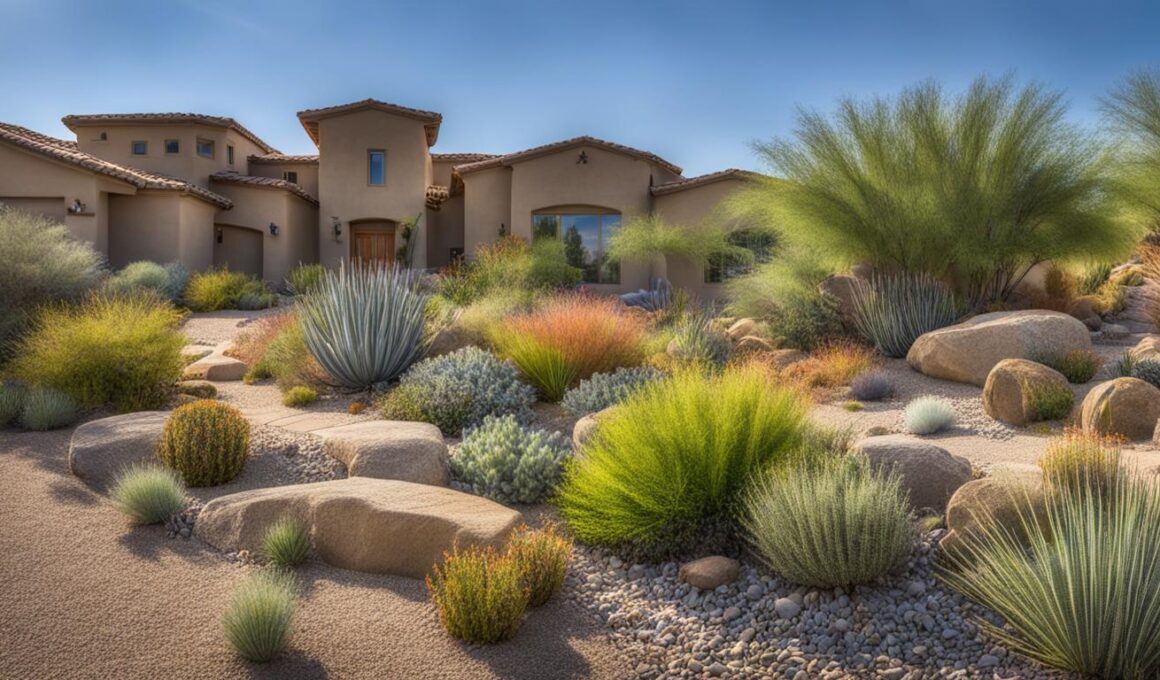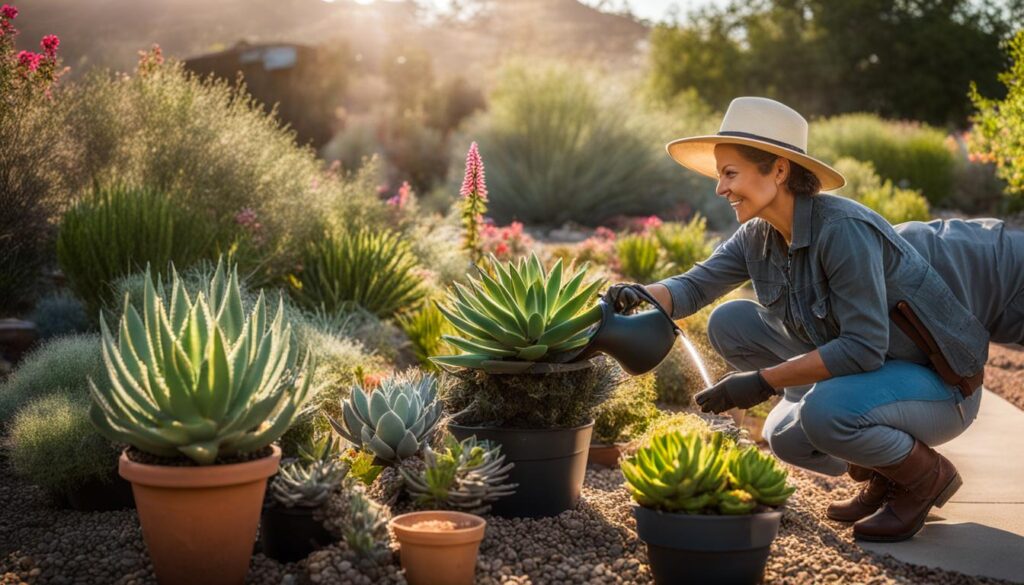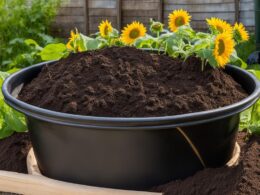Welcome to our comprehensive guide on xeriscaping with native plants. If you’re looking to create a beautiful and sustainable garden while conserving water, then xeriscaping is the perfect solution for you. By utilizing the principles of xeriscaping and incorporating native plants that are well-suited to your local climate, you can design a low-water, eco-friendly oasis that thrives with minimal maintenance. In this guide, we’ll explore the principles of xeriscaping, provide tips for designing a water-wise garden, and highlight the benefits of using native plants in your landscaping projects.
Key Takeaways:
- Xeriscaping is a landscaping technique that focuses on water conservation and sustainability.
- Native plants are adapted to the local climate and require minimal watering to thrive.
- Designing a water-wise garden with xeriscaping involves thoughtful planning and consideration of topography and soil conditions.
- Implementing water-saving techniques such as drip irrigation and mulching can maximize the water efficiency of your xeriscape garden.
- Proper maintenance practices are crucial for the long-term success of your xeriscape garden.
Understanding Xeriscaping: Principles and Benefits
Xeriscaping is a landscaping technique that focuses on water conservation and reducing the environmental impact of traditional landscaping practices. By understanding the principles of xeriscaping and the benefits it offers, you can create a sustainable and beautiful outdoor space.
One of the key principles of xeriscaping is grouping plants by their water needs. This allows you to efficiently water your garden by targeting specific areas that require more moisture. By doing so, you can minimize water waste and ensure that each plant receives the appropriate amount of water for optimal growth.
Using mulch is another important principle of xeriscaping. Mulch helps to retain soil moisture and reduce evaporation, which means less watering is required. It also acts as a natural weed suppressant, reducing the need for chemical herbicides and manual weeding. Additionally, mulch helps to regulate soil temperature and prevent erosion, creating a healthy environment for your plants to thrive.
Choosing drought-tolerant plants is a fundamental aspect of xeriscaping. These plants have evolved to survive in arid conditions and require minimal amounts of water to thrive. By incorporating drought-tolerant plants into your landscape, you can reduce water usage and maintenance efforts while still enjoying a visually appealing garden. Native plants are a great choice for xeriscaping as they are well adapted to the local climate and typically require less water and maintenance compared to non-native species.
“Xeriscaping is not just about saving water, it’s about creating a sustainable landscape that is in harmony with the environment.”
In addition to water conservation, xeriscaping offers several benefits. By practicing xeriscaping, you can save water and reduce your water bills, making it an economical landscaping choice in the long run. Xeriscaped gardens also require less maintenance, as the use of native plants and efficient irrigation systems minimizes the need for constant tending. Furthermore, xeriscaping promotes biodiversity by creating habitats for native wildlife and pollinators.
- Water conservation
- Reduced maintenance
- Cost savings
- Promotion of biodiversity
By embracing the principles of xeriscaping and harnessing its benefits, you can create a sustainable, low-water, and eco-friendly oasis in your outdoor space.
Choosing the Right Plants for Xeriscaping
When it comes to xeriscaping, selecting the right plants is essential for creating a water-efficient and visually appealing garden. Native plants are especially well-suited for xeriscaping as they have adapted to the local climate and require less water to thrive. By incorporating drought-tolerant native plants into your landscape, you can reduce water consumption and create a sustainable outdoor space.
Here are some factors to consider when choosing plants for your xeriscape garden:
- Drought Tolerance: Look for plants that have a naturally high tolerance for dry conditions. These plants are adapted to survive with minimal water and will thrive in your xeriscape garden.
- Sun Exposure: Evaluate the amount of sunlight your garden receives throughout the day. Choose plants that are suitable for the specific light conditions, whether it’s full sun, partial shade, or full shade.
- Soil Requirements: Consider the soil type in your garden and choose plants that are well-suited for it. Native plants are often well-adapted to the local soil conditions and can thrive without the need for extensive amendments.
Examples of drought-tolerant native plants suitable for xeriscaping include ferns, grasses, wildflowers, shrubs, and trees. These plants not only require less water but also provide habitat for local wildlife and contribute to the overall biodiversity of your garden. By selecting the right plants for your xeriscape garden, you can create a beautiful, water-efficient, and environmentally friendly landscape.
Native Plants for Xeriscaping:
“Native plants are an excellent choice for xeriscaping because they have evolved to withstand the local climate conditions. These plants have developed deep root systems, waxy leaves, and other adaptations that help them survive in arid environments. By incorporating native plants into your xeriscape garden, you can create a low-maintenance and eco-friendly landscape that thrives with minimal water.”
Designing a Water-Wise Garden with Xeriscaping
Designing a water-wise garden with xeriscaping involves careful planning and consideration of your garden’s topography, exposure, and soil conditions. By following these design principles, you can create an attractive and sustainable outdoor space that conserves water and promotes the use of native plants.
Creating Planting Zones
When designing your xeriscape garden, it is essential to create planting zones based on the water needs of different plant groups. Group drought-tolerant plants together in sunny areas, as they require less water and can withstand high temperatures. Place more delicate plants that require more water near a water source or in shaded areas. By grouping plants according to their water needs, you can ensure efficient irrigation and minimize water usage.
Incorporating Hardscapes and Rock Gardens
In addition to plant selection, incorporating hardscapes and rock gardens can further reduce the need for traditional lawn grass and water-intensive landscaping features. Install pathways, patios, or decks using materials such as gravel or permeable pavers, which allow water to penetrate the soil instead of running off. Incorporate rock gardens with drought-tolerant plants that can thrive in low-water environments, adding visual interest and texture to your garden.
Using Mulch
Applying mulch is an effective way to conserve soil moisture, suppress weed growth, and enhance the overall aesthetics of your xeriscape garden. Mulch acts as a protective layer, reducing evaporation and minimizing water loss from the soil. Use organic mulch, such as wood chips or straw, to help retain moisture and regulate soil temperature. Apply a layer of mulch around plants, leaving a small gap around the stems to prevent moisture buildup and potential rot.
By incorporating thoughtful design elements such as creating planting zones, using hardscapes and rock gardens, and applying mulch, you can design a water-wise garden with xeriscaping. Remember to consider the specific needs of your local climate and choose native plants that are adapted to your region’s conditions. Designing a water-wise garden not only conserves water but also creates a beautiful and sustainable outdoor space for you to enjoy.
Implementing Water-Saving Techniques in Xeriscaping
When it comes to xeriscaping, implementing water-saving techniques is key to maximizing the efficiency of your garden’s irrigation system. By employing these techniques, you can minimize water usage while still ensuring the health and vitality of your plants. Here are some effective water-saving techniques to incorporate into your xeriscaping:
- Drip Irrigation: Utilize a drip irrigation system to deliver water directly to the root zones of your plants. This targeted approach minimizes water loss through evaporation and reduces the risk of overwatering.
- Well-Draining Soil: Opt for well-draining soil that allows water to penetrate deeply and evenly. This promotes better root growth and water absorption, preventing runoff and water wastage.
- Mulching: Apply a layer of organic mulch, such as wood chips or straw, around your plants. Mulch helps retain soil moisture, prevents weed growth, and regulates soil temperature, reducing the need for frequent watering.
- Smart Watering: Monitor the moisture levels of your soil regularly and adjust your watering schedule accordingly. Avoid watering during the hottest parts of the day to minimize evaporation, and consider using rain barrels to collect and store rainwater for future use.
By implementing these water-saving techniques into your xeriscape garden, you can conserve water resources and create a sustainable and environmentally-friendly outdoor space. Not only will you contribute to a greener planet, but you’ll also enjoy the long-term benefits of reduced water bills and lower maintenance efforts.
Quote:
“Implementing water-saving techniques is essential in xeriscaping to minimize water usage and promote efficient irrigation. Use drip irrigation systems to deliver water directly to the plant roots and minimize evaporation. Install well-draining soil to improve water penetration and retention. Apply mulch to conserve soil moisture and suppress weed growth.”
How Can I Incorporate Native Plants for Xeriscaping in My Garden?
Incorporating native xeriscaping plants care in your garden is a great way to conserve water and promote eco-friendly landscaping. Choose drought-tolerant species like lavender, California poppy, and yarrow to create a beautiful, sustainable landscape. With proper planning and maintenance, your garden can thrive while using minimal water.
Maintaining a Xeriscape Garden
Once you’ve designed and implemented your xeriscape garden, it’s essential to maintain it properly to ensure its long-term success. Regular maintenance tasks will help your garden thrive while reducing the need for excessive watering or chemical treatments. By following these maintenance practices, you can enjoy a beautiful and sustainable xeriscape garden year-round.
1. Weed regularly:
Weeds can compete with your native plants for water and nutrients. Take the time to weed your xeriscape garden regularly to prevent weed growth and maintain a clean and tidy appearance. Use a hand weeder or garden hoe to remove weeds carefully, ensuring you pull out the entire root system to prevent regrowth.
2. Prune and deadhead:
Pruning helps control the growth of shrubs and trees in your xeriscape garden. Remove any dead, damaged, or diseased branches to improve the overall health and appearance of your plants. Additionally, deadheading flowers by removing faded blooms promotes further blooming and keeps your garden looking fresh and vibrant.
3. Monitor watering:
Regularly monitor the moisture levels in your garden to ensure you’re providing the right amount of water. Adjust your watering schedule based on rainfall and the specific needs of your plants. Overwatering can lead to root rot, while underwatering can cause stress and stunted growth. Aim to water deeply but infrequently, allowing the soil to dry out slightly between watering sessions.
4. Pest and disease management:
Vigilant pest and disease management are crucial for the health of your xeriscape garden. Keep an eye out for common garden pests such as aphids, snails, and slugs, and take appropriate measures to control them. Use organic pest control methods whenever possible to minimize the impact on beneficial insects and wildlife. If you notice any signs of disease, such as yellowing leaves or unusual spots, promptly identify the problem and take necessary steps to treat or remove affected plants.
By implementing these maintenance practices in your xeriscape garden, you’ll not only enjoy a thriving and beautiful outdoor space, but you’ll also minimize water usage and reduce the need for harsh chemicals. Take the time to care for your xeriscape garden, and it will reward you with years of low-maintenance beauty and sustainability.
Conclusion
Embrace the art of xeriscaping with native plants and transform your garden into a low-water, eco-friendly oasis. Xeriscaping with native plants offers numerous benefits, including water conservation, cost savings, and habitat creation. By following the principles of xeriscaping and using native plants adapted to your local climate, you can create a sustainable and beautiful outdoor space.
Implementing water-saving techniques, thoughtful design, and proper maintenance will help your xeriscape garden thrive. By using drip irrigation systems, well-draining soil, and applying mulch, you can maximize the water efficiency of your xeriscape garden and reduce the need for excessive watering. Additionally, regular maintenance tasks such as weeding, pruning, and pest management will help your xeriscape garden flourish without relying on chemical treatments or excessive water usage.
With xeriscaping, you can go native and make a positive impact on the environment. By planting native plants that are adapted to your local climate and require minimal water to thrive, you can conserve water resources and create a sustainable landscaping solution. Say goodbye to high water bills and labor-intensive maintenance – xeriscaping with native plants is the way to go for a beautiful, cost-effective, and environmentally friendly garden.














